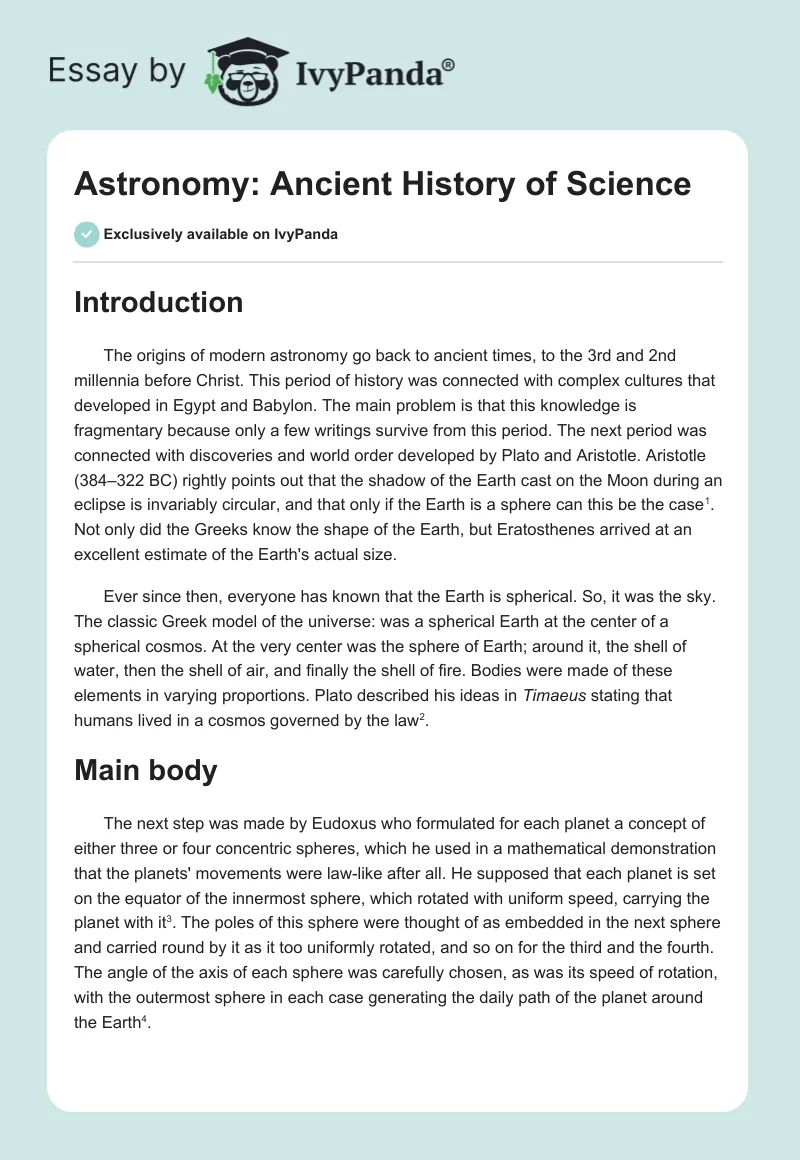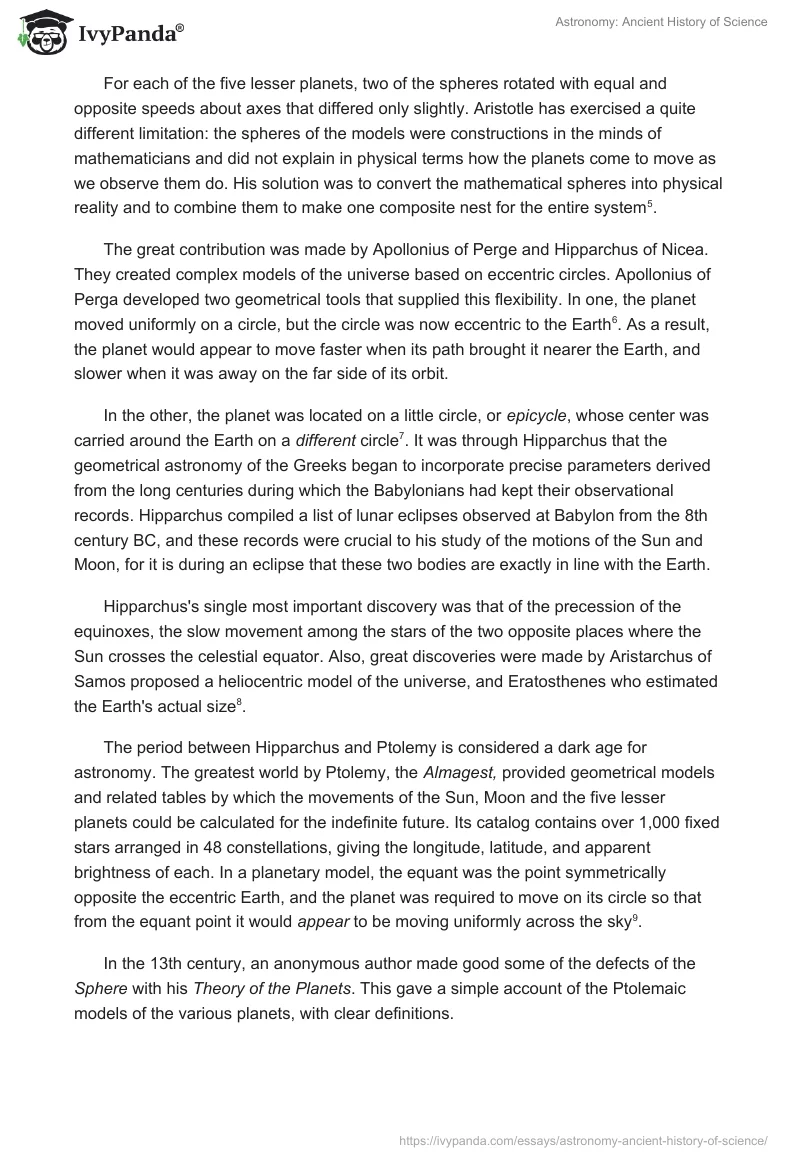Introduction
The origins of modern astronomy go back to ancient times, to the 3rd and 2nd millennia before Christ. This period of history was connected with complex cultures that developed in Egypt and Babylon. The main problem is that this knowledge is fragmentary because only a few writings survive from this period. The next period was connected with discoveries and world order developed by Plato and Aristotle. Aristotle (384–322 BC) rightly points out that the shadow of the Earth cast on the Moon during an eclipse is invariably circular, and that only if the Earth is a sphere can this be the case. Not only did the Greeks know the shape of the Earth, but Eratosthenes arrived at an excellent estimate of the Earth’s actual size.
Ever since then, everyone has known that the Earth is spherical. So, it was the sky. The classic Greek model of the universe: was a spherical Earth at the center of a spherical cosmos. At the very center was the sphere of Earth; around it, the shell of water, then the shell of air, and finally the shell of fire. Bodies were made of these elements in varying proportions. Plato described his ideas in Timaeus stating that humans lived in a cosmos governed by the law.
Main Body
The next step was made by Eudoxus who formulated for each planet a concept of either three or four concentric spheres, which he used in a mathematical demonstration that the planets’ movements were law-like after all. He supposed that each planet is set on the equator of the innermost sphere, which rotated with uniform speed, carrying the planet with it. The poles of this sphere were thought of as embedded in the next sphere and carried round by it as it too uniformly rotated, and so on for the third and the fourth. The angle of the axis of each sphere was carefully chosen, as was its speed of rotation, with the outermost sphere in each case generating the daily path of the planet around the Earth.
For each of the five lesser planets, two of the spheres rotated with equal and opposite speeds about axes that differed only slightly. Aristotle has exercised a quite different limitation: the spheres of the models were constructions in the minds of mathematicians and did not explain in physical terms how the planets come to move as we observe them do. His solution was to convert the mathematical spheres into physical reality and to combine them to make one composite nest for the entire system.
The great contribution was made by Apollonius of Perge and Hipparchus of Nicea. They created complex models of the universe based on eccentric circles. Apollonius of Perga developed two geometrical tools that supplied this flexibility. In one, the planet moved uniformly on a circle, but the circle was now eccentric to the Earth. As a result, the planet would appear to move faster when its path brought it nearer the Earth, and slower when it was away on the far side of its orbit.
In the other, the planet was located on a little circle, or epicycle, whose center was carried around the Earth on a different circle. It was through Hipparchus that the geometrical astronomy of the Greeks began to incorporate precise parameters derived from the long centuries during which the Babylonians had kept their observational records. Hipparchus compiled a list of lunar eclipses observed at Babylon from the 8th century BC, and these records were crucial to his study of the motions of the Sun and Moon, for it is during an eclipse that these two bodies are exactly in line with the Earth.
Hipparchus’s single most important discovery was that of the precession of the equinoxes, the slow movement among the stars of the two opposite places where the Sun crosses the celestial equator. Also, great discoveries were made by Aristarchus of Samos proposed a heliocentric model of the universe, and Eratosthenes who estimated the Earth’s actual size.
The period between Hipparchus and Ptolemy is considered a dark age for astronomy. The greatest world by Ptolemy, the Almagest, provided geometrical models and related tables by which the movements of the Sun, Moon and the five lesser planets could be calculated for the indefinite future. Its catalog contains over 1,000 fixed stars arranged in 48 constellations, giving the longitude, latitude, and apparent brightness of each. In a planetary model, the equant was the point symmetrically opposite the eccentric Earth, and the planet was required to move on its circle so that from the equant point it would appear to be moving uniformly across the sky.
In the 13th century, an anonymous author made good some of the defects of the Sphere with his Theory of the Planets. This gave a simple account of the Ptolemaic models of the various planets, with clear definitions.
Meanwhile, at the court of King Alfonso X of Castile, the old Toledan Tables were replaced by the Alfonsine Tables; modern computer analysis has shown that these tables, which would be standard for the next 300 years, were calculated on Ptolemaic models with only the occasional updating of parameters. Oresme saw a significant implication of the concept of impetus. If the Earth were indeed rotating, the archer as he stood on its surface would be moving with it. As a result, as he prepared to fire the arrow, he would unknowingly confer on the arrow a sideways impetus. Endowed with this impetus, the arrow in flight would travel horizontally as well as vertically, keeping pace with the Earth, and so would fall to the ground at the very place from which it had been fired.
The next stage of scientific development was connected with Nicolaus Copernicus (1473–1543) and new scientific discoveries. Critics admit that many years passed, during which Copernicus developed his mathematical astronomy, remote from the intellectual centers of Europe. Copernicus’s book, De Revolutionibus, was concerned with geometrical models of the planetary orbits. The Prutenic Tables of Erasmus Reinhold (1511–53) proved that the heliocentric approach “could pass the practical test”. Copernicus outlined the consequences that follow from the basic assumption that the Earth is an ordinary planet orbiting the Sun.
The heliocentric universe was a true cosmos: “In the center of all resides the Sun. For in this most beautiful temple, who would place this lamp in another or better place than that from which it can illuminate the whole at one and the same time? As a matter of fact, not inappropriately do some call it the lantern of the universe; others, its mind; and others still, its ruler”. These discoveries were made and proved by other scientists including Galileo Galilei.
Conclusion
It is possible to say that it was difficult to overturn the geocentric model because scientists had not had a possibility to prove their observations and investigate outer space. Most of their discoveries were hypothetically proved by mathematical and geometric formulas and estimates. The development of a telescope of 8 magnification opened new possibilities for scientists to discover the universe. Until the invention of the telescope, each generation of astronomers had looked at much the same sky as their predecessors. If they knew more, it was chiefly because they had more books to read, more records to mine.
In contrast, Galileo saw with his telescope wonders vouchsafed to no one before him: stars that had remained hidden from sight, four moons that orbited the planet Jupiter, strange appendages to Saturn that would be recognized as rings only half a century later, moon-like phases of Venus, mountains on the Moon not very different from those on Earth, even spots on the supposedly perfect Sun. He was able to confirm the suggestion of Aristotle that the Milky Way is composed of myriads of tiny stars. So, scientific revolution opened new possibilities for scientists to resolve the physical objections.
Bibliography
Couper, H., N. Henbest, Clarke, A.C. The History of Astronomy. Firefly Books, 2007.
Heilbrin, J. L. The Oxford Guide to the History of Physics and Astronomy. Oxford University Press, USA, 2005.
Evans, J. The History and Practice of Ancient Astronomy. Oxford University Press, USA, 1998.
Pannekoek, A. A History of Astronomy. Dover Publications; New Ed edition, 1989.


